COMPOUND MICROSCOPE
MAKER:CARPENTER or CARPENTER & WESTLEY (Attrib)
MODEL: NEW IMPROVED COMPOUND MICROSCOPE FOR OPAKE AND TRANSPARENT OBJECTS
c. 2nd Quarter 19th C.
Authors:Jurriaan de Groot and Barry Sobel
'
Editor: Joe Zeligs
Please Click On Any Picture for a Larger Version
INTRODUCTION:
This is an example of an Improved Compound Microscope, probably produced for Carpenter or Carpenter & Westley, but unsigned. It has a Ross label in the case, with a Ross address dating to 1880 to 1893, which is much later than the date this microscope was made. It is assumed this was sold by Ross after being traded in earlier. Another example of this model of microscope, retailed by T.B. Mathews, is also on this site.
DESCRIPTION:
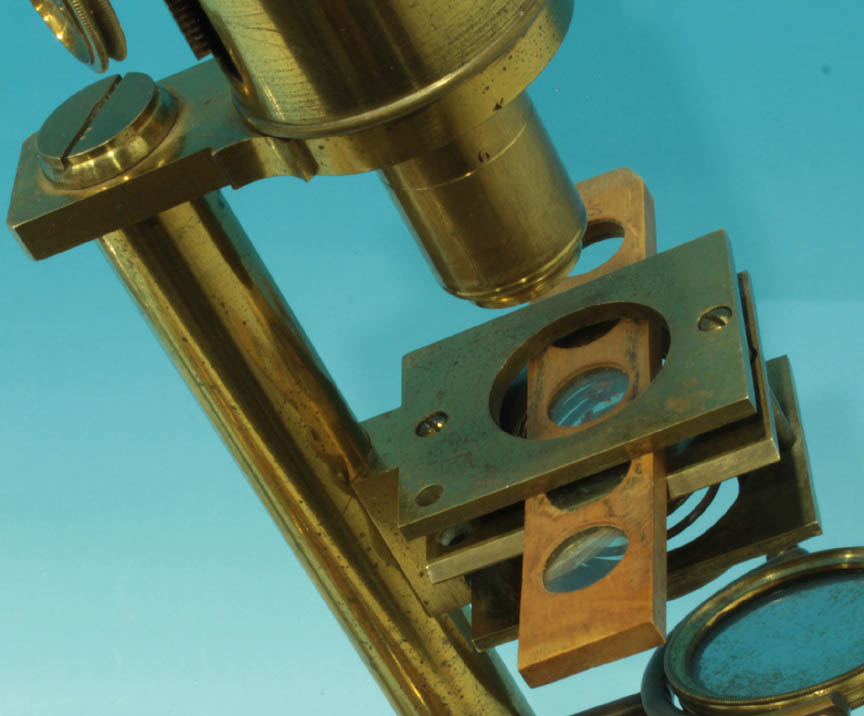 The flat folding tripod feet are each of different lengths so as to allow them to fold up. They measure about 127, 120 and 112 mm from their centers to their ends respectively. The tripod supports, via a compass joint, a 150 mm tall round pillar with an arm at the top which carries the body tube. The coarse focusing arrangement resembles that as used in Martin drum microscopes of the mid 19th century, and also some early 19th century Culpeper types; it works by rack and pinion, with rackwork between a fixed outer cylinder and a moving inner tube which includes the optical tube and nosepiece assembly. There is no fine focus adjustment. There is a Bonani-type square stage (left) which is sprung, holding the slide against a stationary square, while at the same time forming a
The flat folding tripod feet are each of different lengths so as to allow them to fold up. They measure about 127, 120 and 112 mm from their centers to their ends respectively. The tripod supports, via a compass joint, a 150 mm tall round pillar with an arm at the top which carries the body tube. The coarse focusing arrangement resembles that as used in Martin drum microscopes of the mid 19th century, and also some early 19th century Culpeper types; it works by rack and pinion, with rackwork between a fixed outer cylinder and a moving inner tube which includes the optical tube and nosepiece assembly. There is no fine focus adjustment. There is a Bonani-type square stage (left) which is sprung, holding the slide against a stationary square, while at the same time forming a safety stage
which prevents accidental damage to the slide and objective while focusing; it measures about 57 mm front to back and about 44 mm right to left. The bottom plate has a tapered edge to facilitate the insertion of the slides which have also have tapered ends for the same purpose. The bottom of the stage is fitted with a circular sleeve to hold a slip-on diffusing glass to reduce glare and provided a more even illumination field for lower power observations. A single gimbaled concave mirror is affixed to the bottom end of the pillar. The eyepiece consists of two eye lenses and one field lens. The elongated nosepiece is marked 1 to 6 indicating the position of a brass sleeve holding a silvered Lieberkuhn for each numbered objective, though numbers 1 and 2 are not visible unless the nosepiece is unscrewed from the rest of the inner tube. The instrument stands about 460 mm tall with objective No 4 in use.
ACCESSORIES:
OBJECTIVES:
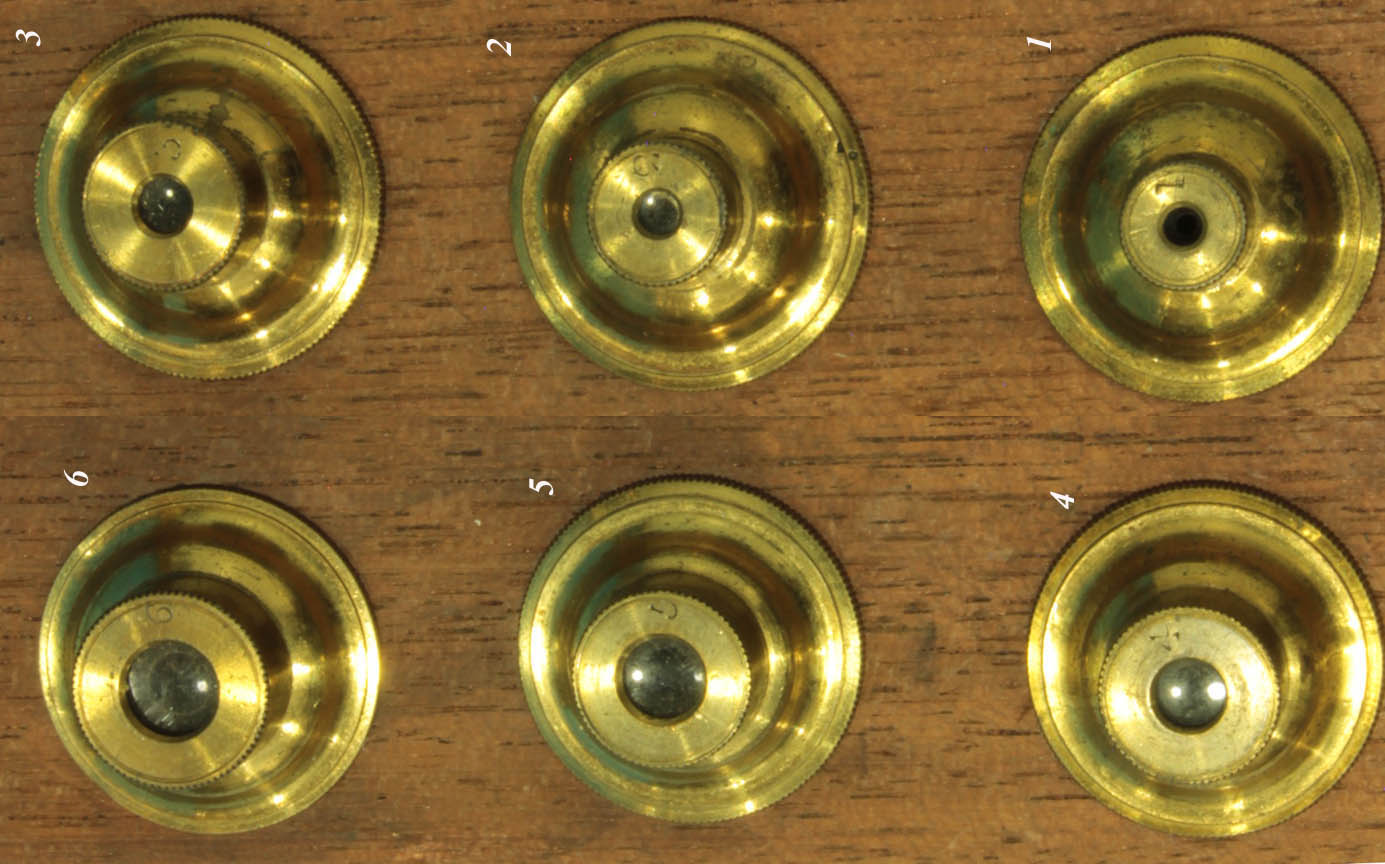 These include 6 numbered non-achromatic objectives each containing a single bi-convex lens. Unlike a later example on this site, this microscope does not contain any achromatic objective.
These include 6 numbered non-achromatic objectives each containing a single bi-convex lens. Unlike a later example on this site, this microscope does not contain any achromatic objective.
OPTICAL DATA OBTAINED BY JURRIAAN DE GROOT OF ANOTHER SIMILAR INSTRUMENT USING EIKENOMETER AND ZEISS APERTOMETER:
| OBJECTIVE | APPROXIMATE N.A. | MAGNIFICATION WITH EYEPIECE |
|---|
| No. 6 |
0.04 |
26 |
| No. 5 |
0.05 |
35 |
| No. 4 |
0.06 |
50 |
| No. 3 |
0.08 |
63 |
| No.2 |
0.08 |
92 |
| No. 1 |
0.11 |
280 |
| Achr button1 |
0.11 |
108 |
OTHER ACCESSORIES:
These include a live box (aquatic box
), understage frosted glass light diffuser(dead glass for moderating light
), candle holder, forceps(tongs
), Lieberkuhn sleeve with detachable Lieberkuhn(silver speculum
), a handheld magnifier, a round brass-edged cup to hold specimens in liquid (plain glass with brass rim
), a single glass slide of the same length as the bone sliders, and a stage forceps(plyers
). A replica light shade fitting over the top of the microscope, and a reprint of original instructions have been added, as has a replacement stand for the candle holder and a replacement period bullseye condenser.
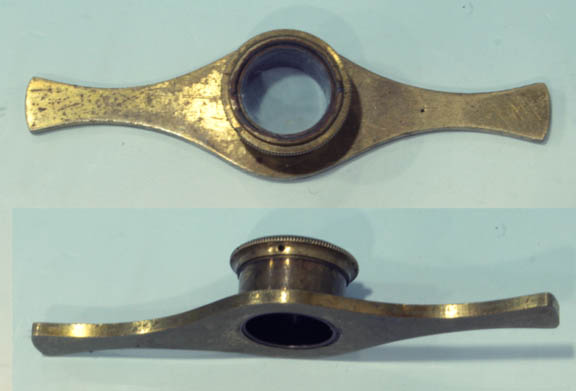
The livebox is meant to house a subject in liquid. The top has a tiny hole near the top of the cap which allows excess liquid to drain as the cap is replaced; this hole could be sealed with e.g. wax after that to prevent evaporation if desired.
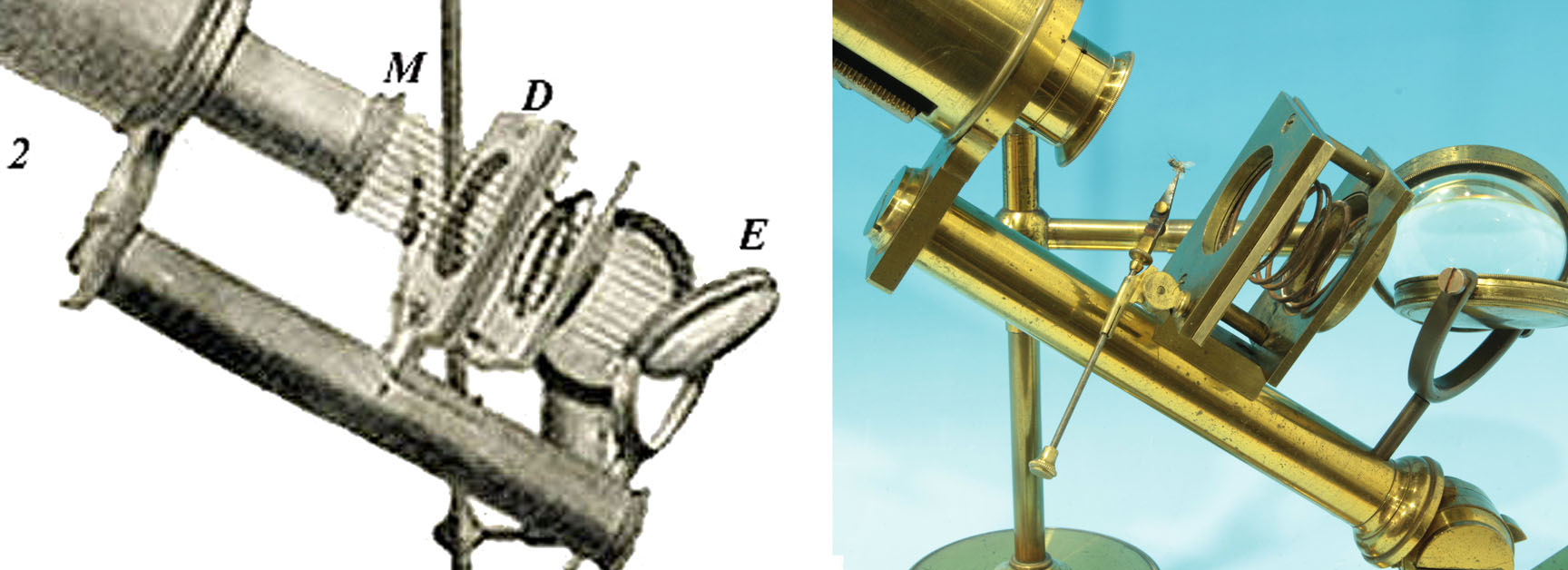 The Lieberkuhn
The Lieberkuhn silver speculum reflector
is used for directing light directly on top of an object such as a fly. The light is directed from the bullseye condenser onto the mirror and from there up through the stage and around the subject to the Lieberkuhn which directs it down onto the opaque object which is then illuminated from above. This system requires the subject be small enough so that the light can be be directed around it from below the stage to reach the reflector. For this reason, the instructions for the use of the microscope note that objects in the larger slides needed to be removed from the slide and attached to the stage forceps to allow this. Later in the 19th century, when slides were more commonly made of glass, small objects could be viewed without the need to remove them from their slide since the glass slides were transparent.
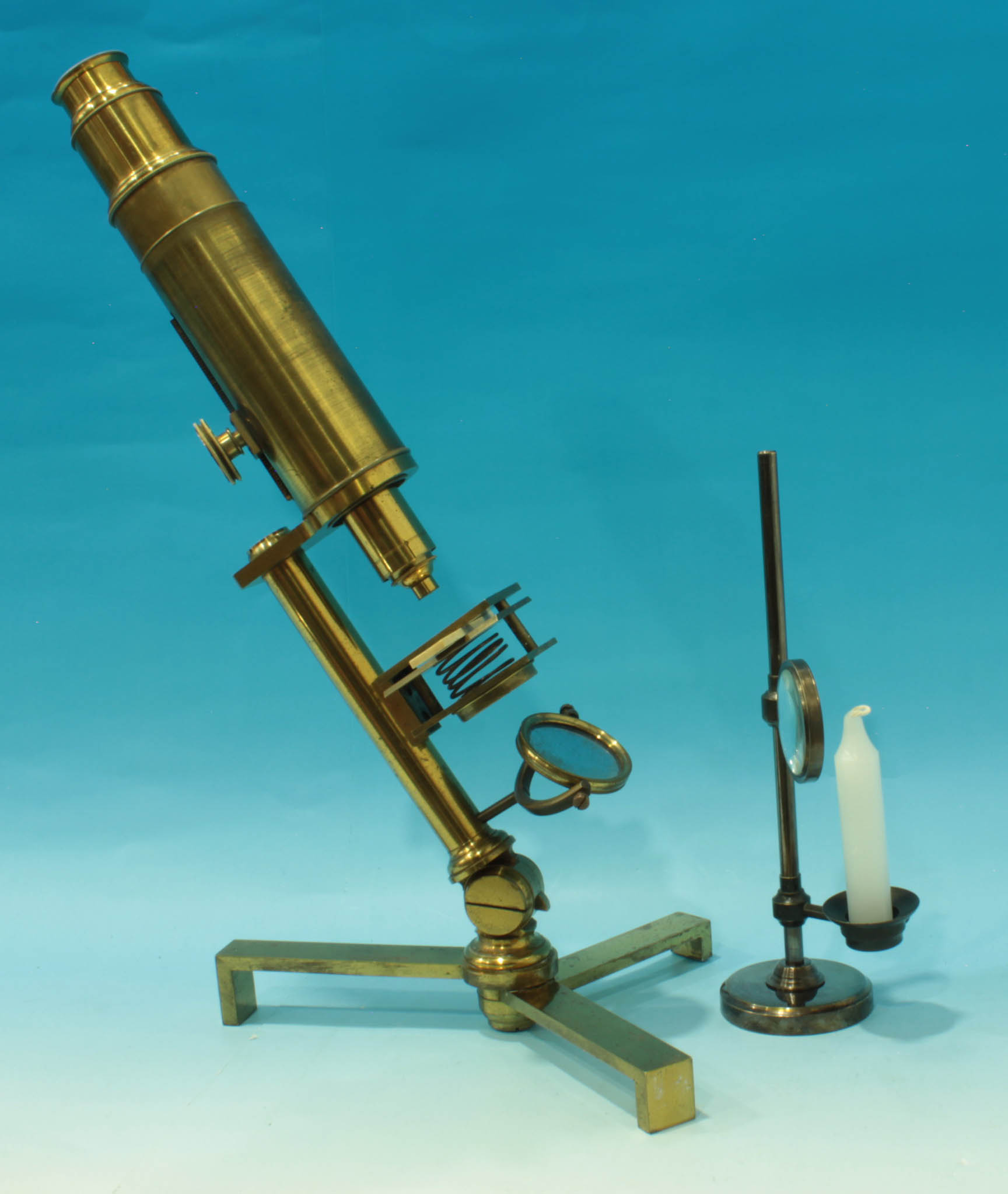 The combined candle stand and bullseye condenser, is shown here setup for transmitted illumination. An example of another (original) example is shown from the other Carpenter microscope on this site; they were often finished in oxidized brass. The original bullseye featured a two component, screw-together lens, the components to be used together for opaque specimens, but just one for illuminating the mirror. The present example came with the candle holder but was missing the stand and the bullseye, so modified period replacements were provided by the present owner, noting the bullseye is not divisible like in the original.
The combined candle stand and bullseye condenser, is shown here setup for transmitted illumination. An example of another (original) example is shown from the other Carpenter microscope on this site; they were often finished in oxidized brass. The original bullseye featured a two component, screw-together lens, the components to be used together for opaque specimens, but just one for illuminating the mirror. The present example came with the candle holder but was missing the stand and the bullseye, so modified period replacements were provided by the present owner, noting the bullseye is not divisible like in the original.
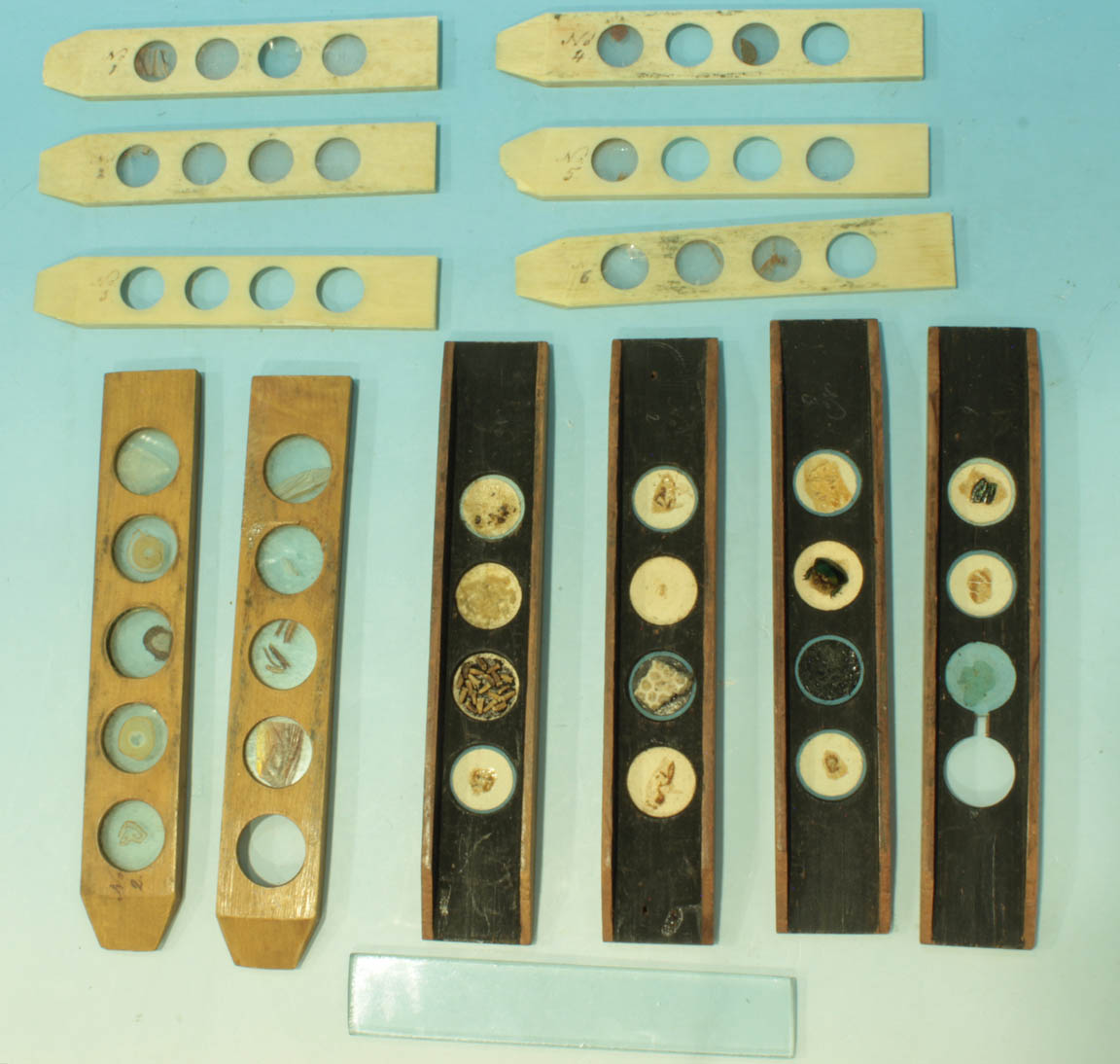
The set comes with three sets of slides,each accommodated under the lift-out tray in the case: 6 numbered (No 1 to No 6)bone sliders with transparent objects, four larger wooden slides with raised edges containing both transparent and opaque speciments, numbered No 1,No 2,No 3 and No 6 and two traditional wooden sliders with transparent specimens numbered No 1 and No 2. As noted above the leading edge of each slide is tapered to facilitate sliding them between the sprung plates of the stage.
CASE:
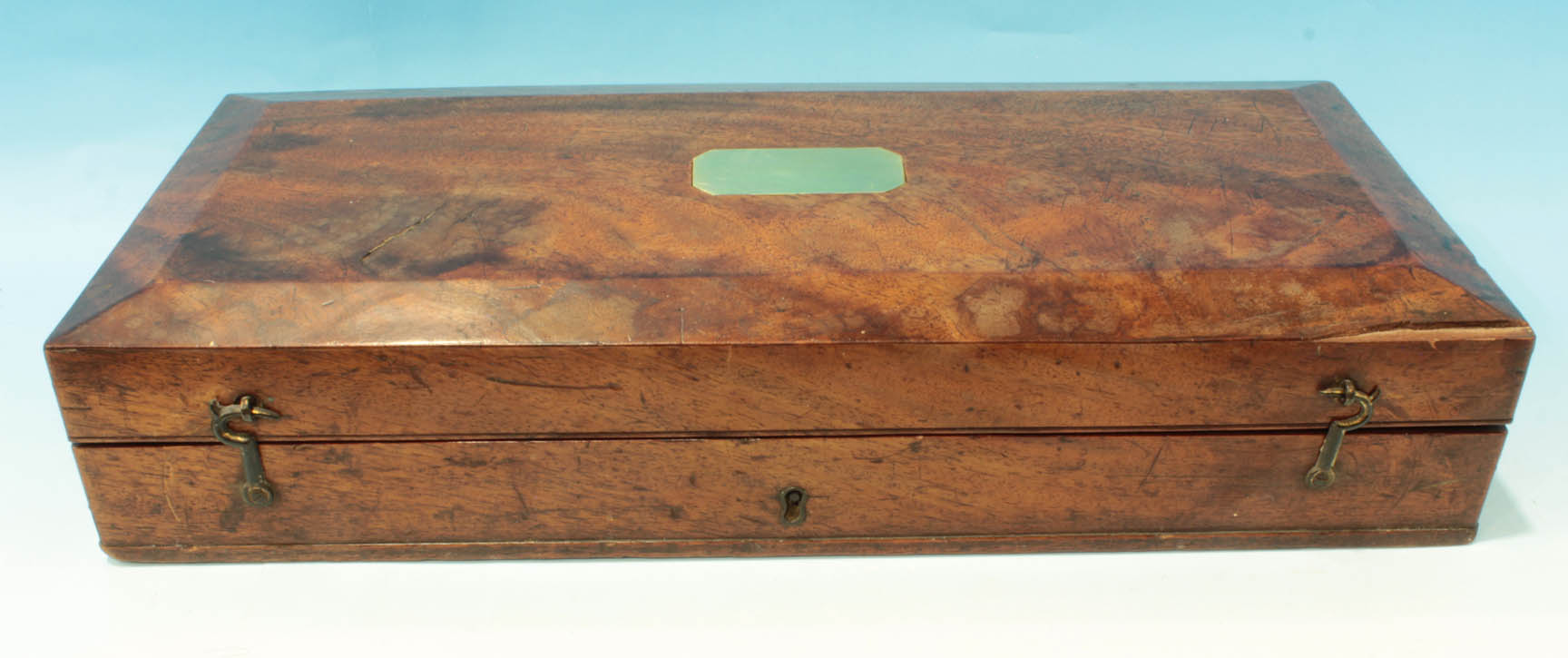 The bevelled-edge flame mahogany veneer case measures about 400 x 180 x 78 mm and the inner lid is lined with a thick padding covered with purple-brown velvet. This lining pad has a tab to lift it up, under which the instructions and a light screen were stored.
The bevelled-edge flame mahogany veneer case measures about 400 x 180 x 78 mm and the inner lid is lined with a thick padding covered with purple-brown velvet. This lining pad has a tab to lift it up, under which the instructions and a light screen were stored.
There is a lift-out tray containing the objectives, and a number of the smaller accessories, with the round base for the rod of the candleholder support, upright rod, and candle holder stored in the bottom of the case with the lieberkuhn on top of the candle holder.
CONDITION:
As purchased, the microscope and accessories are in overall good condition with the case have some damage to one corner and the microscope having scattered relatively mild losses to the original lacquer. The talc box is missing as is the needle holder. Objective number 6 has lost its lens. Of the original 6 wooden sliders of opaque specimens two of these slides are missing. The rest of the original slides are present, though several of the slides are missing one or more specimens.
The bullseye and the stand for the bullseye and candle holder are modified period replacements.
DIFFERENCES BETWEEN THIS MICROSCOPE AND THE OTHER ON THIS SITE:
This outfit differs slightly from the other example on this site. The forceps and the stage forceps are both a bit different. The live box on this example has a slightly different shape. Finally, the stage top plate on this example is square, whereas the other example has a U-shaped stage top plate, open in the front.
HISTORY OF PHILIP CARPENTER AND MICROSCOPES RETAILED BY HIM:
 The flat folding tripod feet are each of different lengths so as to allow them to fold up. They measure about 127, 120 and 112 mm from their centers to their ends respectively. The tripod supports, via a compass joint, a 150 mm tall round pillar with an arm at the top which carries the body tube. The coarse focusing arrangement resembles that as used in Martin drum microscopes of the mid 19th century, and also some early 19th century Culpeper types; it works by rack and pinion, with rackwork between a fixed outer cylinder and a moving inner tube which includes the optical tube and nosepiece assembly. There is no fine focus adjustment. There is a Bonani-type square stage (left) which is sprung, holding the slide against a stationary square, while at the same time forming a
The flat folding tripod feet are each of different lengths so as to allow them to fold up. They measure about 127, 120 and 112 mm from their centers to their ends respectively. The tripod supports, via a compass joint, a 150 mm tall round pillar with an arm at the top which carries the body tube. The coarse focusing arrangement resembles that as used in Martin drum microscopes of the mid 19th century, and also some early 19th century Culpeper types; it works by rack and pinion, with rackwork between a fixed outer cylinder and a moving inner tube which includes the optical tube and nosepiece assembly. There is no fine focus adjustment. There is a Bonani-type square stage (left) which is sprung, holding the slide against a stationary square, while at the same time forming a  These include 6 numbered non-achromatic objectives each containing a single bi-convex lens. Unlike a later example on this site, this microscope does not contain any achromatic objective.
These include 6 numbered non-achromatic objectives each containing a single bi-convex lens. Unlike a later example on this site, this microscope does not contain any achromatic objective.

 The Lieberkuhn
The Lieberkuhn  The combined candle stand and bullseye condenser, is shown here setup for transmitted illumination. An example of another (original) example is shown from the other Carpenter microscope on this site; they were often finished in oxidized brass. The original bullseye featured a two component, screw-together lens, the components to be used together for opaque specimens, but just one for illuminating the mirror. The present example came with the candle holder but was missing the stand and the bullseye, so modified period replacements were provided by the present owner, noting the bullseye is not divisible like in the original.
The combined candle stand and bullseye condenser, is shown here setup for transmitted illumination. An example of another (original) example is shown from the other Carpenter microscope on this site; they were often finished in oxidized brass. The original bullseye featured a two component, screw-together lens, the components to be used together for opaque specimens, but just one for illuminating the mirror. The present example came with the candle holder but was missing the stand and the bullseye, so modified period replacements were provided by the present owner, noting the bullseye is not divisible like in the original.
 The bevelled-edge flame mahogany veneer case measures about 400 x 180 x 78 mm and the inner lid is lined with a thick padding covered with purple-brown velvet. This lining pad has a tab to lift it up, under which the instructions and a light screen were stored.
The bevelled-edge flame mahogany veneer case measures about 400 x 180 x 78 mm and the inner lid is lined with a thick padding covered with purple-brown velvet. This lining pad has a tab to lift it up, under which the instructions and a light screen were stored.